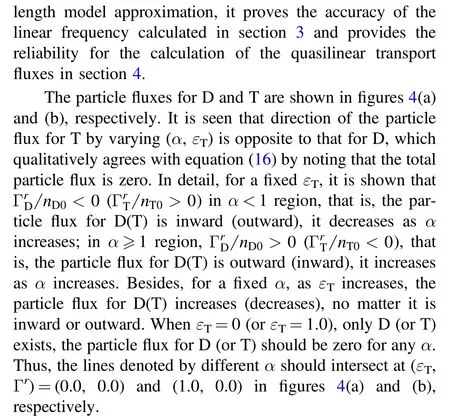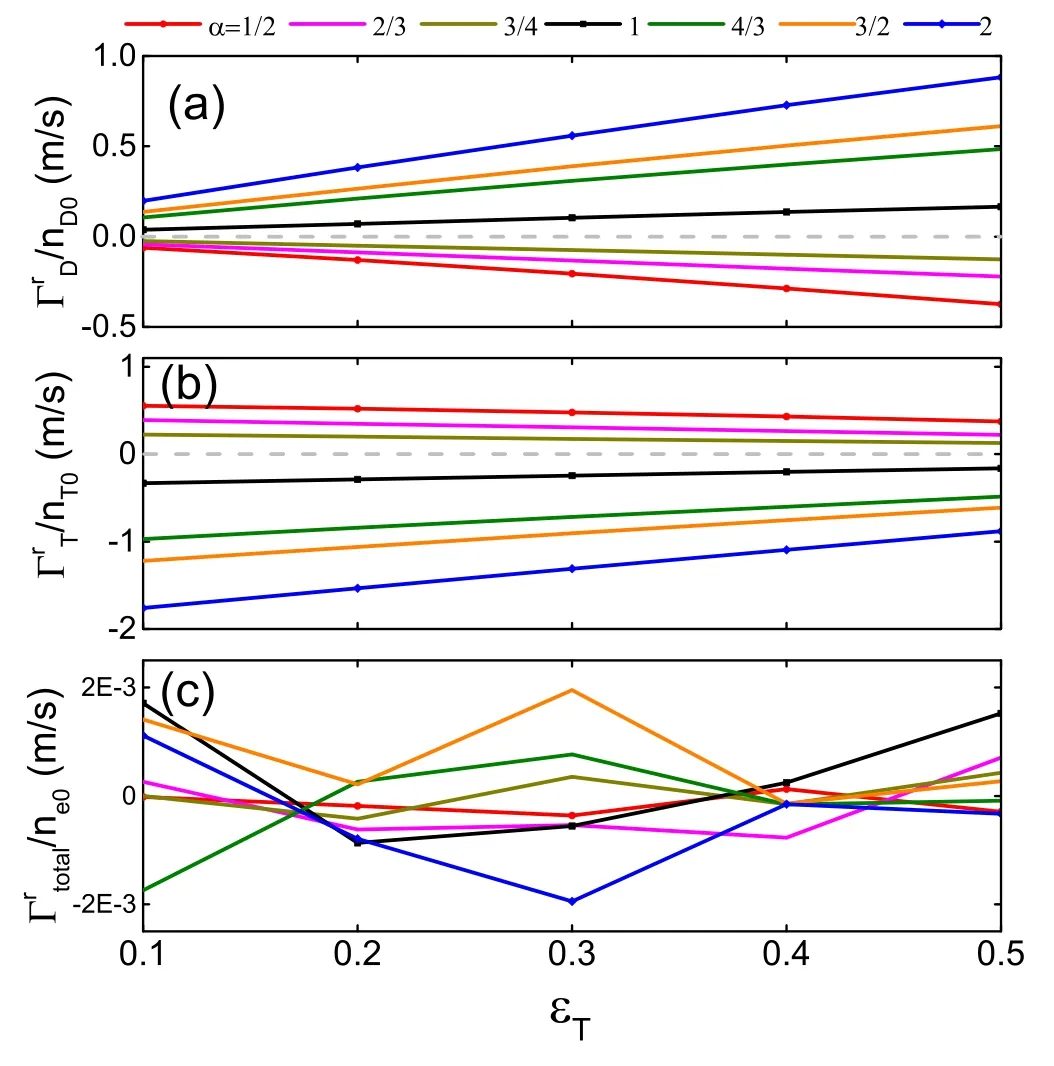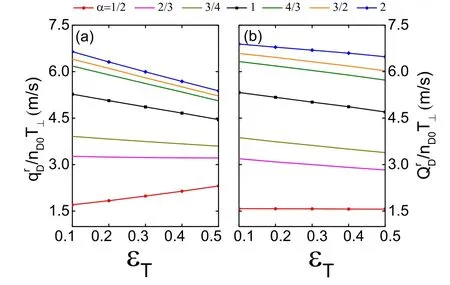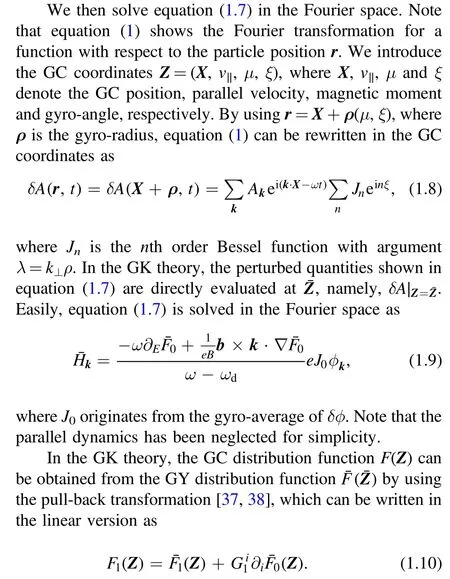Anomalous transport driven by ion temperature gradient instability in an anisotropic deuterium-tritium plasma
2022-03-10DebingZHANG张德兵LiminYU虞立敏ErbingXUE薛二兵XianmeiZHANG张先梅andHaijunREN任海骏
Debing ZHANG(张德兵),Limin YU(虞立敏),Erbing XUE(薛二兵),Xianmei ZHANG(张先梅),*and Haijun REN(任海骏)
1 Department of Physics,East China University of Science and Technology,Shanghai 200237,People's Republic of China
2 School of Physical Science and CAS Key Laboratory of Geospace Environment,University of Science and Technology of China,Hefei 230026,People's Republic of China
Abstract In this work,the anomalous transport driven by the ion temperature gradient instability is investigated in an anisotropic deuterium-tritium(D-T)plasma.The anisotropic factor α,defined as the ratio of perpendicular temperature to parallel temperature,is introduced to describe the temperature anisotropy in the equilibrium distribution function.The linear dispersion relation in local kinetic limit is derived,and then numerically evaluated to study the dependence of mode frequency on the anisotropic factor α of D and the fraction of T particle εT by choosing three sets of typical parameters,denoted as the cyclone base case,ITER and CFETR cases.Based on the linear results,the mixing length model approximation is adopted to analyze the quasi-linear particle and energy fluxes for D and T.It is found that choosing small α and large εT is beneficial for the confinement of particle and energy for D and T.This work may be helpful for the estimation of turbulent transport level in the ITER and CFETR devices.
Keywords:deuterium-tritium plasma,ion temperature gradient instability,temperature anisotropy,turbulent transport,mixing length model approximation
1.Introduction
The confinement of particle and energy is a key issue in tokamaks.Since the experimental observation of the anomalous ion thermal transport in DIII-D tokamak[1],the research for the heat transport has been developed prosperously.The ion temperature gradient(ITG)instability is considered to play an important role in the anomalies in ion thermal transport[2,3].
The fusion temperature can be reached through the intense auxiliary heating,such as the neutral beam injection(NBI)heating,ion cyclotron resonance heating(ICRH)as well as electron cyclotron resonance heating.These heating regimes have been widely used in the existent tokamaks such as EAST,JET,DIII-D,and will be adopted in the fusion tokamaks such as ITER and CFETR for the realization of deuterium-tritium(D-T)discharge.Nevertheless,the auxiliary heating regimes could produce strong plasma anisotropy.Generally,tangentially injected NBI drives the anisotropy withT‖>T⊥,and the ICRH typically generates perpendicularly dominant anisotropy withT⊥>T‖,whereT‖andT⊥are the parallel and perpendicular temperatures with respect to the magnetic field.Anisotropic plasma has been experimentally observed.For instance,studies in MAST suggest that the ratioT⊥/T‖=1.7 is achieved[4].In EAST,the degree of the parallel-dominated anisotropyT‖/T⊥=1.8 is reached at low electron density with low hybrid wave heating[5].
Influences of the temperature anisotropy on plasma behaviours have been widely researched.The temperature anisotropy plays important roles in the ITG instability[6],the resistive wall mode[7],the low-frequency electromagnetic wave[8],the geodesic acoustic mode[9-11],the zonal flows[12,13]and so on.In detail,in[6],it is demonstrated that instability of ITG mode is reduced by an ion temperature anisotropy of higher perpendicular temperature or high enough parallel temperature.In[13],it is found that the residual zonal flow driven by the ITG instability shows a strong dependence on the temperature ratioIn[14],it is reported that in the ITG driven turbulence in tokamak plasmas,the different parallel and perpendicular temperaturesT‖≠T⊥induced by the ion Bernstein wave heating plays an important role in the generation and dynamics of transport barriers.In[15],the theoretical analysis and numerical evaluation of the impurity flux for the stellarator plasmas suggest that the main ion pressure anisotropy must be taken into account for a correction description of impurity transport in most of the collisionality range.
In this work,we focus on the ITG instability in a temperature anisotropic D-T plasma.The linear dispersion relation is theoretically derived and numerically solved to analyze the effects of temperature anisotropy on the linear behaviour of ITG instability;based on the linear results,the mixing length model approximation is adopted to analyze the anomalous particle and energy transport.The remaining part of this paper is organized as follows.In section 2,dispersion relation of the ITG instability in an anisotropic D-T plasma is derived;in section 3,the linear frequency of ITG instability is numerically evaluated;in section 4,by adopting the mixing length model approximation,the particle flux and energy flux driven by the ITG instability are analyzed;section 5 is the conclusion and discussion.
2.Dispersion relation







Table 1.Key parameters of three cases. a is the minor radius.
3.Linear version




In figure 3,the real frequency and growth rate versuskθρs,Din the CBC,ITER and CFETR cases are shown.It is found that tendencies of the dependence of(normalized)real frequency on α and εTin the ITER and CFETR cases are similar with those in the CBC case;for a fixed(kθρs,D,α,εT),the(normalized)real frequency in three cases are of the same order.Tendencies of the dependence of(normalized)growth rate in the ITER case on α and εTare similar with those in the CBC case,except that the magnitude is about 30% smaller.The magnitude of growth rate in the CFETR case is close to that in the CBC case in a large range of α and εT,however,the tendency is not quite similar.It is seen that by varying εTfrom 0.0 to 0.5,the growth rate in the CFETR case is nearly unchanged when α=1/2,and only about 20% increment when α=1 and 2 in largekθρs,Dregion.Analogously,dependence of the growth rate on α is not quite obvious.When α varies from 1/2 to 2,the increment of the growth rate in the CFETR case is about 50%,which is much smaller than the increments in the CBC and ITER cases.These results show that the ITG instability is the weakest in the ITER case,and is least affected by varying α and εTin the CFETR case.
To end this section,we make some remarks on the results about the linear frequency.In our modelling,only the temperature anisotropy of D is considered;effects of the anisotropy factor αDand the fraction of T εTon the linear frequency depend on this assumption.Obviously,when the temperature anisotropy of T is also considered,the situation becomes complicated.For example,in the case with εTincreased,though the influence of temperature anisotropy from D decreases,the influence of temperature anisotropy from T increases,and the final results depend on the competition of the temperature anisotropy between D and T.In this work,we do not focus on the analysis of this complicated situation,but emphasize the significant role of the temperature anisotropy on the linear frequency in a relatively easy way.
4.Quasilinear transport
In this section,based on the linear results in section 3,a quasilinear transport model is adopted to study the effects of temperature anisotropy on the particle and energy fluxes driven by the ITG instability.



4.1.Particle flux


According to the definition in equations(10)and(13a),the particle flux can be divided into three parts:one is driven by the density gradient(L11X1),the second is driven by the temperature gradient(L12X2+L13X3),and the third is due to the inward pinch(L14X4+L15X5).Totally speaking,as α and εTvaried,the linear real frequency and growth rate vary,then the transport coefficients calculated from equation(15)vary,leading to the variation of the contribution from these three parts to the particle flux.The analysis about the contribution from these three parts to the particle flux may be helpful to understand the tendency of the particle flux varied with α and εT.As an example,we take εT=0.5,α=1/2,1 and 2.The values are summarized in table 2.It is shown that with different α,the flux driven by the density gradient is always outward,the flux due to the inward pinch is always inward,the flux driven by the temperature gradient can be inward or outward.For a fixed α,the density gradient parts and the inward pinch parts for D and T are similar,but the temperature gradient parts for D and T are quite different,especially when α=1/2 and 2.As α increased from 1/2 to 2,the density gradient parts for D and T increase;the inward pinch parts for D and T increase;the temperature gradient part for D(T)changes from inward(outward)to outward(inward),correspondingly,the particle flux for D(T)changes from inward(outward)to outward(inward).The similar results can also be obtained for εT=0.1 to 0.4.It is indicated that the temperature gradient part plays an important role in determining the direction of particle flux for D and T.
Figure 5 shows the particle flux versus εTin the CBC,ITER and CFETR cases.α=1/2,1 and 2 are adopted.Totally speaking,tendencies of the particle flux for D and T versus(εT,α)in the ITER and CFETR cases are similar with those in the CBC case.In large range of chosen(εT,α),the particle fluxes for D and T are about 0.5 m s-1,0.03 m s-1and 0.2 m s-1in the CBC,ITER and CFETR cases,respectively,that is,the particle flux is the largest in the CBC case and smallest in the ITER case.These results can be qualitatively explained by combining equation(15)and figure 3.Thetransport coefficient shown in equation(15)is proportional to γ3and χGB,both γ and χGBin the ITER case are about half of those in the CBC and CFETR cases,resulting that the particle flux in the ITER case is about an order of magnitude smaller.It is seen that the particle flux in the CFETR case is smaller than that in the CBC case,which is closely related to the contribution from the temperature gradient part and the inward pinch part.We take εT=0.5 as an example.When α=2,the particle fluxes for D in the CBC and CFETR case are 0.882 m s-1and 0.321 m s-1,respectively;however,the temperature gradient parts in the CBC and CFETR case are 0.795 m s-1and -0.712 m s-1,respectively.The bigger outward particle flux for D in the CBC case is mainly due to the positive contribution from the temperature gradient part.When α=1/2,the particle fluxes for D in the CBC and CFETR case are -0.375 m s-1and -0.162 m s-1,respectively;however,the inward pinch parts in the CBC and CFETR case are -1.108 m s-1and -0.460 m s-1,respectively.The bigger inward particle flux for D in the CBC case is mainly due to the positive contribution from the inward pinch part.

Figure 1.Real frequency(a)-(c)and growth rate(d)-(f)versus kθρs,D with εT varied in the CBC case.α=1/2,1 and 2.The normalized frequency cs/R=156 kHz; R=R0+0.5a is adopted,where the biggest temperature gradient occurs.

Figure 2.Real frequency(a)-(c)and growth rate(d)-(f)versus kθρs,D with α varied in the CBC case.εT=0.0,0.1 and 0.5.

Figure 3.Real frequency(a)-(c)and growth rate(d)-(f)versus kθρs,D in the CBC,ITER and CFETR cases.α=1/2,1 and 2,εT=0.0 and 0.5.The normalized frequency cs/R=156 kHz(CBC),96 kHz(ITER),116 kHz(CFETR);here,R=R0+0.5a for ITER and R=R0+0.6a for CFETR.

Figure 4.Particle flux versus εT with α varied in the CBC case.(a)D;(b)T and(c)total.The gray dash line denotes Γr=0.

Figure 5.Particle flux versus εT in the(a)CBC,(b)ITER and(c)CFETR cases.α=1/2,1 and 2.Solid:D,dash:T,dot:total.

Table 2.Contribution from the density gradient(L11 X1),the temperature gradient(L12 X2+ L13 X3),and the inward pinch(L14 X4+ L15 X5)to the particle flux(total).The unit for the flux is m s-1.εT=0.5,and α=1/2,1,2.‘←’ and ‘→’ denote the inward and outward particle flux,respectively.
Generally,the inward or smaller outward particle flux means the better particle confinement.In figure 5,it is shown that for a fixed εT,the particle fluxes for both D and T are closer to zero when α approaches to 1 than that when α is far away from 1,indicating that the confinement is better for the isotropic case than that for the anisotropic case.On the other hand,for the anisotropic case,it is found that for a certain α <1,larger εT(for example,α=1/2 and εT=0.5)is beneficial for the particle confinement;for a certain α >1,smaller εT(for example,α=2 and εT=0.1)is beneficial for the particle confinement.
4.2.Energy flux
Figure 6 shows the heat and energy fluxes for D versus εTin the CBC case.The heat and energy fluxes are calculated according to equations(13c)and(13b),respectively.It is seen that for a fixed εT,both the heat and energy fluxes increase as α increases,dependences of the heat and energy flux on α are more sensitive in α <1 region than that in α >1 region.For εT=0.5,when α increases from 1/2 to 1,the heat flux increases from about 2.3 to about 4.5 m s-1,the increment is about 96%;when α increases from 1 to 2,the heat flux increases from about 4.5 to about 5.4 m s-1,the increment is about 20%.As shown in equation(13c),the heat flux contains two parts,which are denoted as the perpendicular heat flux(J2)and the parallel heat flux(J3).A careful analysis shows that the perpendicular part dominates the heat flux(in our cases,the ratios of the parallel part to the total heat flux are 1%,14% and 20% for α=1/2,1 and 2 with εT=0.5,respectively).Furthermore,the perpendicular heat flux is dominated by the temperature gradient part(L22X2+L23X3).It is found that dependence of the heat flux on α has the similar tendency to that of the temperature gradient part.

Figure 6.Heat(a)and energy(b)flux for D versus εT with α varied in the CBC case.

Figure 7.Heat(a)and energy(b)flux for T versus εT with α varied in the CBC case.
As shown in equation(13b),the energy flux contains the particle flux and the heat flux.According to figures 4(a)and 6(a),the particle flux is much smaller than the heat flux,thus the heat flux dominates the energy flux.It is seen that dependence of the energy flux on α is similar to that of the heat flux.In addition,for a fixed α,dependence of the heat flux on εTis just opposite to that of the particle flux,which leads to that the energy flux moderately decreased as εTincreases.When εTvaries from 0.1 to 0.5,the biggest change of energy flux occurs at α=1,which is dropped from about 5.3 to about 4.7 m s-1.It indicates that the energy transport can be significantly reduced in the situation where the parallel temperature dominates(α <1),and effectively aggravated in the situation where the perpendicular temperature dominates(α >1).
Figure 7 shows the heat and energy fluxes for T versus εTin the CBC case.It is seen that dependence of the heat flux for T on(α,εT)and its value are similar to those for D.The heat flux for T increases as α increases,and the increment is more significant in α <1 region.Analogously,the perpendicular heat flux dominates the heat flux,and the temperature gradient part dominates the perpendicular heat flux.Unlike the situation for the heat flux,dependence of the energy flux on(α,εT)shows different characters.Since the particle flux for T is comparable to the heat flux for T,due to the modulation of particle flux,the energy flux is not sensitive to εT,and its value obviously increases(decreases)in α <1(α >1)region,where the particle flux is outward(inward).It is seen that the biggest energy flux appears at α=1.When α is far away from α=1,the energy flux for T can be moderately suppressed by about 20%-40% in the chosen parameter ranges.

Figure 8.Energy flux for D(solid)and T(dash)versus εT.(a)CBC;(b)ITER;(c)CFETR.
Figure 8 shows the energy flux versus εTin the CBC,ITER and CFETR cases.α=1/2,1 and 2 are adopted.Tendencies of the energy flux for D and T versus(εT,α)in the ITER and CFETR cases are similar with those in the CBC case.In each case,qualitatively,dependence of the energy flux for D on α is more significant than that for T,dependences of the energy flux for both D and T on εTare not obvious,which are due to the modulation of the particle flux,as illustrated in the following figures 6 and 7.Quantitatively,analogous to the particle flux shown in figure 5,the energy flux in the ITER case is an order of magnitude smaller than that in the CBC case,which is due to the smaller growth rate and χGB,as is discussed following figure 5.The energy flux in the CFETR case is about half of magnitude smaller than that in the CBC case.Note that the energy flux can also be divided into three parts,which are driven by the density gradient,the temperature gradient and the inward pinch.As an example,in table 3,we show the contribution from these three parts to the energy flux for D with εT=0.5 and α=1/2,1 and 2.It is shown that in the CBC case,the density gradient part and the inward pinch are mostly cancelled,the value of the total energy flux is close to that of the temperature gradient part.In the CFETR case,values of these three parts are smaller than those in the CBC case.Though the transport coefficients described by equation(15)are close in CBC and CFETR cases,the fluxes are not close,since the the fluxes are calculated by the product of transport coefficients and driving forces(Xν).For example,in our modelling,the biggerRresults in the smaller energy flux in the CFETR case.
Besides,it is seen that the optimal confinement for the energy of D and T appears at α=1/2,regardless of the value of εT.

Table 3.Contribution from the density gradient part,the temperature gradient part and the inward pinch part to the energy flux for D in the CBC and CFETR cases.The unit for the flux is m s-1.εT=0.5,and α=1/2,1,2.
5.Conclusion and discussion
In conclusion,the particle and energy transports driven by the ITG instability are investigated in an anisotropic D-T plasma.
At first,the linear dispersion relation is derived in the local kinetic limit.Three sets of typical parameters,denoted as CBC,ITER and CFETR case,respectively,are chosen to numerically solve the dispersion relation.Dependences of the linear mode frequency on parameters,such as the temperature anisotropy factor of D α,the fraction of T particle εTand the poloidal spectrumkθρs,D,are studied.Based on the linear results,the quasilinear transport coefficients are derived by adopting the mixing length model approximation,and the particle and energy fluxes for D and T are evaluated.
The main results are concluded as follows:
(1)Dependences of the linear frequency and the quasilinear transports on the parameters in the three cases show the similar tendency.Values of the real frequency in the three cases are nearly the same,the growth rate is the smallest in the ITER case,and largest in the CBC case.The quasilinear particle and energy transports are the largest in the CBC case and the smallest in the ITER case,which indicates the better particle and energy confinement in large devices.
(2)As α increases,the real frequency decreases,while the growth rate increases;in α >1(α <1)region,the real frequency increases(decreases)as εTincreases,while the growth rate decreases(increases).The ITG instability may be significantly stabilized by controlling α <1.
(3)Due to the adiabatic electron approximation and the quasi-neutrality condition,the total particle flux for ions is found to be zero;this result proves the accuracy for the calculation of the linear frequency and provides the reliability for the calculation of the quasilinear transport fluxes.The direction of the particle flux for D is opposite to that of T;the temperature gradient driven particle flux plays an important role in determining the direction of the particle flux for D and T.It is shown that the particle confinement is better for the isotropic case than that for the anisotropic case when εTis fixed.On the other hand,for the anisotropic case,it is found that for a certain α <1(α >1),larger εT(smaller εT)is beneficial for the particle confinement.
(4)As α increases,the heat fluxes for D and T increase,the increment is more sensitive in α <1 region than that in α >1 region.Due to the modification of the particle flux,dependences of the energy flux for D and T on α show different tendencies.As α increases,the energy flux for D increases,while the energy flux for T increases in α <1 region and then decreases in α >1 region.The largest energy flux for T appears at α=1;as the deviation of α is larger from 1,the energy flux becomes smaller.It is concluded that smaller α is beneficial for energy confinement.
(5)Totally speaking,in the ITG-dominated regime,the better particle and energy confinement occur by choosing smaller α and larger εT.
To the end,it should be pointed out that a significant source of anisotropy in high performance machines is NBI,which may also produce a sheared flow in the plasma.Consideration of the consistency between temperature anisotropy and sheared flows may be helpful for a better estimation of turbulent transport level in devices such as ITER and CFETR.This issue will be left as a future work.
Acknowledgments
This work was supported by the National MCF Energy R&D Program of China(No.2019YFE03060000),and National Natural Science Foundation of China(Nos.12005063,12175228,11875131 and 11675053).
Appendix.Derivation of the perturbed distribution function from the traditional GK theory.




杂志排行
Plasma Science and Technology的其它文章
- Investigation of short-channel design on performance optimization effect of Hall thruster with large height-radius ratio
- Multi-layer structure formation of relativistic electron beams in plasmas
- Mode structure symmetry breaking of reversed shear Alfvén eigenmodes and its impact on the generation of parallel velocity asymmetries in energetic particle distribution
- Interaction between energetic-ions and internal kink modes in a weak shear tokamak plasma
- Investigation of the compact torus plasma motion in the KTX-CTI device based on circuit analyses
- Nonlinear excitation of a geodesic acoustic mode by reversed shear Alfvén eignemodes
